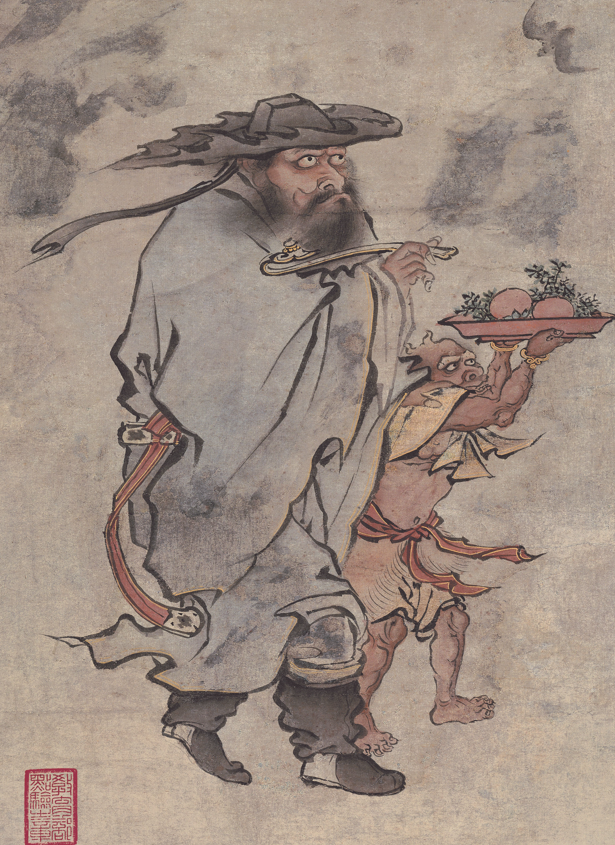
“Wuri Zhong Kui” 午日鍾馗 (Zhong Kui on [Double] Fifth Day) by Hua Yan 華嵒 (1682-1756), inscribed with his own poem
Picture credit: National Palace Museum, Taipei
Zhong Kui 鍾馗 is a guardian figure traditionally associated with Double Fifth Day, or the Dragon Boat Festival (which falls on 3 June this year). It is the custom to hang up his images or symbols to ward off evil spirits. In visual traditions, the paintings for this occasion typically represent Zhong Kui as a stern or even fearsome figure accompanied by one or several demons he has subdued. One may also find other auspicious symbols like the bat (fu 蝠, a pun for fu 福, “blessing”). It is very uncommon to see a relaxed Zhong Kui, made mortal and enjoying himself in the garden, served by his demon slaves. Here, he is just like every other man on this day, drinking xionghuangjiu 雄黃酒 (realgar liquor) and eating zongzi 粽子 (a type of sticky rice wrap), both typical of this festival. Such a humorous play on the traditional theme provides a telling example of the artist’s creativity.
黃油紙繖日邊遮。 Shaded by a tawny oiled-paper canopy in the sunlight,
中酒鍾馗紗帽斜。 Zhong Kui is inebriated, his gauze cap slanting,
醉眼也隨蜂蝶去。 His drunken gaze trailing behind bees and butterflies
小西園裡鬧群花。[1] That bustle around in the flowers of the small western garden.
新羅山人華喦寫于綠筠小閣。
By Hua Yan, Mountain Man of Xinluo[2], in the gazebo in verdant bamboo
[1] Red characters rhyme. [2] Xinluo 新羅 was an old name for Shanghang 上杭 (in modern Fujian province) and the birthplace of Hua Yan.
Detail of "Suichao jiazhao tu" 歲朝佳兆圖 by Zhu Jianshen 朱見深, the Chenghua Emperor of the Ming (1447-1487, ruling 1464-1487); collection of the Palace Museum, Beijing (https://www.dpm.org.cn/collection/paint/231146.html)
Detail of "Wuri Zhong Kui" 午日鍾馗 by Qian Gu 錢穀 (fl. early 16th century); collection of the National Palace Museum, Taipei
An image of Zhong Kui by an anonymous artist; © The Trustees of the British Museum
Copyright Declaration*:
The texts and images used on the website of Rachelle's Lab are either from the public domain (e.g. Wikipedia), databases with open data licenses (e.g. Shuhua diancang ziliao jiansuo xitong 書畫典藏資料檢索系統, National Palace Museum, Taipei), online libraries that permit reasonable use (e.g. ctext.org), or original work created for this website.
Although fair use of the website for private non-profit purposes is permitted, please note that the website of Rachelle's Lab and its content (including but not limited to translations, blog posts, images, videos, etc.) are protected under international copyright law. If you want to republish, distribute, or make derivative work based on the website content, please contact me, the copyright owner, to get written permission first and make sure to link to the corresponding page when you use it.
版權聲明:
本站所使用的圖片,皆出自公有領域(如維基)、開放數據庫(如臺北故宮博物院書畫典藏資料檢索系統)、允許合理引用的在線圖書館(如中國哲學電子化計劃)及本人創作。本站允許對網站內容進行個人的、非營利性質的合理使用。但請注意,本站及其內容(包括但不限於翻譯、博文、圖像、視頻等)受國際版權法保護。如需基於博客內容進行出版、傳播、製作衍生作品等,請務必先徵求作者(本人)書面許可,并在使用時附上本站鏈接,註明出處。
*Read more about copyright and permission here.







Comments